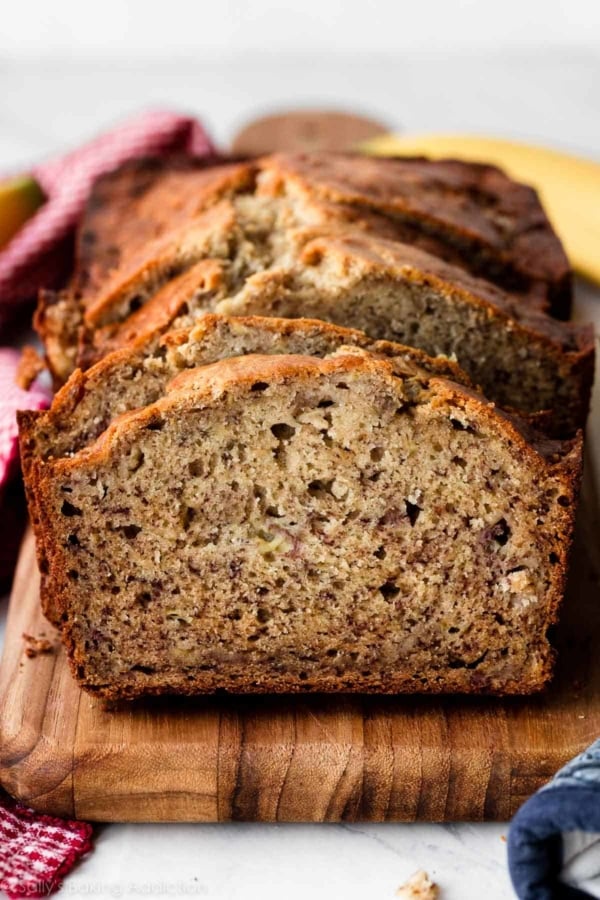Yeasted bread has never been easier. This simple method produces the most beautiful and crusty cranberry nut no-knead bread with very little hands-on work! If you’re new to working with yeast, reference my Baking with Yeast Guide for answers to common yeast FAQs.
I originally published this recipe in 2017 and have since added new photos and a few more success tips.

“Homemade bread” and “easy” are terms that don’t typically go hand-in-hand. When you think of homemade bread, you think difficult, right? This recipe, however, will completely change that thought. I realize that’s a pretty big promise, but I’m confident your perception of homemade bread will switch from “nope! too much work” to “wow, I CAN do this.”
One reader, Kris, commented: “This is an excellent recipe—bread made easy. Delicious bites full of flavor from the cranberries and walnuts. Will keep this forever. ★★★★★”
Another reader, Linda, commented: “This recipe is fantastic. The bread had a wonderful crust and great flavor. The instructions were super thorough at explaining everything for a novice bread maker. ★★★★★”
Why You’ll Love This Cranberry Nut No-Knead Bread:
- Just 7 simple ingredients
- Hardly any hands-on time
- Variety of textures: crispy crusty exterior, soft and chewy interior, and plenty of dried cranberries and nuts in every slice
- An egg-free baking recipe and dairy-free recipe
- Tastes incredible warm with a swipe of honey butter.

This bread, like my homemade artisan bread, seeded oat bread, pizza bread, asiago-crusted skillet bread, and olive bread, has all the bells and whistles of a fresh-from-the-bakery cranberry nut bread, and takes very little effort. If you are new to working with yeast, or simply feeling a little lazy, this recipe is for you.
Making this loaf will leave you plenty of time to loaf around. 😉
Just 7 Ingredients for This Cranberry Nut Bread
You don’t need a lot of ingredients to make homemade bread, and you might already know that if you’ve tried this sandwich bread recipe. You only need 7 ingredients to make this bread:
- Flour: Flour gives the bread its structure. You can use all-purpose or bread flour. I typically reach for bread flour because it yields a slightly chewier bread.
- Salt: Pick up some coarse sea salt; I find the flavor is lacking with regular table salt.
- Yeast: You can use instant or active dry yeast, but I highly recommend an instant (aka “rapid rise” or “quick rise” yeast). I always use Platinum Yeast by Red Star, which is an instant yeast with dough improvers. You don’t need much here—only 1/2 teaspoon—because of the long rise time.
- Nuts: Walnuts or pecans—baker’s choice!
- Dried Cranberries: I love the chewy texture of dried cranberries here. Don’t use fresh or frozen cranberries, because this dough is too wet. Raisins would work too, or try chopping up dried apricots or dates.
- Water: I normally encourage you to use warm liquid with yeast because it helps the yeast work faster. For this recipe, you want the water to be about 95ºF (35ºC), because we’re encouraging a nice slow rise to build flavor. An instant-read thermometer takes the guesswork out of this.
- Honey: Honey adds flavor and helps give the bread its springy, sponge-like texture.

By the way, if you enjoy honey in your homemade bread, you’ll love this no-knead honey oat bread because the flavor really stands out. The process is also very similar to today’s easy bread recipe. And both breads are delicious warm or toasted and topped with this easy homemade honey butter.
Overview: 5 Steps to Make No-Knead Bread
This no-work, no-knead, professional-bread-at-home concept originated with Jim Lahey of Sullivan Street Bakery in NYC. It’s all very basic ingredients, but his method is unique, which includes an 18-hour rise time. 18 hours?! Yes! Don’t be nervous, this 18 hours gives the dough a chance to ferment. And the fermentation time requires absolutely nothing from you. Just set it on your counter and forget about it until the next day. We use this same method for homemade English muffins. In both recipes, the magic happens when you’re not looking!
Step 1: Stir ingredients together. Don’t even break out your mixer.
This will be a super sticky dough. Remember, do NOT be tempted to add more flour. It will stick to your hands. That’s nothing a quick wash can’t fix!


Step 2: Cover the dough and ignore it.
Let the dough rise at room temperature for 12–18 hours. This recipe is very forgiving. Any normal-ish room temperature is fine. You’ll know that the dough is finished rising when it has about doubled in size and air bubbles have formed on top. Like this:

Step 3: The dough will still be super sticky after rising. That’s ok! Using lightly floured hands, form the sticky dough into a ball and place on a large piece of parchment paper. Score the top with a sharp knife, kitchen shears, or bread lame, then allow to rest for 30 minutes.


Step 4: Preheat a 5- to 6-quart Dutch oven. You’ll bake the bread in a pre-heated (super-hot!) Dutch oven, which helps form a crusty exterior. If you don’t have a Dutch oven, you can use any oven-safe heavy-duty pot with a lid.
Step 5: Bake for about 35 minutes. For an accurate doneness test, the bread is done when an instant-read thermometer reads the center of the loaf as 195°F (90°C).


FAQ: Why Bake No-Knead Bread in a Dutch Oven?
Baking the bread with the lid on traps steam inside the pot, creating that perfectly crisp crust. A lid is the secret to this bread recipe’s success! You won’t regret picking up a Dutch oven.
No Dutch oven? No problem.
While baking the bread in a Dutch oven is key to this bread’s texture, you can get around it. Instead, place the rounded dough on a parchment paper-lined or generously floured nonstick baking pan. No need to pre-heat the pan like you do the Dutch oven. While the oven preheats and the scored loaf is resting, boil a kettle of water. After the oven is preheated, place scored dough/baking pan on the center rack. Then place a shallow metal baking/roasting pan or cast-iron skillet (I usually use a metal 9×13-inch baking pan; do not use glass) on the bottom oven rack. Carefully and quickly pour 3–4 cups of boiling water into it, and then quickly shut the oven door to trap the steam inside. The steam helps create a crispier crust. This is exactly how I bake 4-ingredient artisan bread.
Step 6: Enjoy a slice of warm, fresh bread you won’t believe you made from scratch.

This lightly honey-sweetened cranberry nut bread is fabulous for breakfast, toasted with butter or honey butter. Or serve it alongside a charcuterie board with a soft cheese like brie or goat cheese, or this white cheddar cranberry pecan cheese ball (yum!).
This recipe is brought to you in partnership with Red Star Yeast.
Print
Crusty Cranberry Nut No Knead Bread
- Prep Time: 30 minutes
- Cook Time: 35 minutes
- Total Time: 20 hours
- Yield: 1 loaf; 10-12 servings
- Category: Bread
- Method: Baking
- Cuisine: American
Description
Yeasted bread has never been easier. This simple mixing method produces the most beautiful and crusty cranberry nut no-knead bread with very little hands-on work! If you’re new to working with yeast, reference my Baking with Yeast Guide for answers to common yeast FAQs.
Ingredients
- 3 cups + 2 Tablespoons (390g) bread flour or all-purpose flour (spooned & leveled), plus more as needed
- 2 teaspoons coarse sea salt (I find the flavor lacking with regular table salt)
- 1/2 teaspoon Platinum Yeast from Red Star instant yeast
- 3/4 cup (95g) chopped walnuts or pecans
- 3/4 cup (105g) dried cranberries*
- 1 Tablespoon (21g) honey
- 1 and 1/2 cups (360ml) warm water (about 95°F (35°C))
Instructions
- *No need to grease the bowl, and do not use a mixer in this step because the dough is too sticky for a mixer.* In a large bowl using a silicone spatula, stir the first 5 ingredients together. Mix the honey and water together, then pour on top. Mix to combine. (Note that in the video below, I add the honey to the dry ingredients instead of mixing first with water, but you can do it either way.) The dough will be very sticky; don’t be tempted to add more flour, you want a sticky dough. Gently shape into a ball as best you can.
- Cover tightly. Set on the counter at room temperature (honestly any normal room temperature is fine) and allow to rise for 12–18 hours. The dough will double in size, stick to the sides of the bowl, and may have air bubbles on the surface.
- Turn the dough out onto a lightly floured work surface and, using lightly floured hands, shape into a ball as best you can. It doesn’t have to be perfect. Transfer the dough to a large piece of parchment paper. (Large enough to fit inside your pot and one that is safe for high heat. I use this parchment and it’s never been an issue.) Using a very sharp knife, kitchen shears, or a bread lame, gently score an X into the top. Place the ball of dough + parchment inside a bowl so the dough doesn’t spread out as it rests. Cover dough lightly with plastic wrap or a clean kitchen towel and let it rest for 30 minutes.
- During this rest, preheat the oven to 475°F (246°C). (Yes, very hot!) Place your Dutch oven (with the lid) or heavy-duty pot in the oven for 30 minutes so that it’s extremely hot before the dough is placed inside. After 30 minutes, remove the Dutch oven and carefully place the dough inside by lifting it up with the parchment paper and placing it all—the parchment paper included—inside the pot. Cover with the lid.
- Bake for 25 minutes with the lid on. Carefully remove the lid and continue baking for 8–10 more minutes until the bread is golden brown. How to test for doneness: Give the warm bread a light tap. If it sounds hollow, it’s done. For a more accurate test, the bread is done when an instant-read thermometer reads the center of the loaf as 195°F (90°C).
- Remove pot from the oven, carefully remove the bread from the pot, and allow to cool on a wire rack for at least 20 minutes before slicing.
- Cover and store leftover bread at room temperature for up to 1 week.
Notes
- Make Ahead & Freezing Instructions: The dough takes up to 18 hours to rise, so this is a wonderful recipe to begin 1 day ahead of time. To freeze, bake and cool the bread, wrap in a layer of plastic wrap, then a layer of aluminum foil, and freeze for up to 3 months. Thaw in the refrigerator, and then allow to come to room temperature before serving. You can also freeze the dough. Mix the dough together as instructed in step 1. Wrap the sticky dough in lightly oiled plastic wrap and place in a freezer-friendly container. Thaw at room temperature, then let it rest/rise as instructed in step 2. Proceed with step 3 and the rest of the recipe.
- Special Tools (affiliate links): Glass Mixing Bowl | Lodge Cast Iron Dutch Oven or Le Creuset Dutch Oven | Parchment Paper | Bread Lame | Instant-Read Thermometer | Cooling Rack
- Dutch Oven: Use a 5- to 6-quart (or larger) Dutch oven or any large oven-safe pot with an oven-safe lid. If your Dutch oven is smaller than 5 quarts, you can halve the recipe (instructions remain the same, just halve each ingredient) or make the dough as instructed in step 1, shape the dough into 2 balls instead of 1 ball, and bake them one at a time in your smaller Dutch oven. While the 2nd dough waits, lightly cover and keep at room temperature. The bake times in the recipe above (25 mins and then 8–10 mins) will both be a little shorter for the smaller loaves.
- No Dutch oven? See post above for alternative.
- Flour: You can use either bread flour or all-purpose flour here. Bread flour will produce a slightly chewier bread. Feel free to substitute up to 1 cup (around 130g) of the flour for whole-wheat flour. Do not use all whole-wheat flour, as the bread will taste quite dense and heavy.
- Yeast: If you don’t have instant yeast, you can use active dry. I’ve never had a problem using active dry yeast in this recipe, and with no other changes needed. Works wonderfully!
- Cranberries: Dried cranberries (or raisins) are best for this wet dough. I do not recommend frozen or fresh cranberries.
- Parchment Paper: If your parchment paper has a maximum temperature that’s lower than the temperature called for in the recipe, bake the bread at that temperature. Bake the bread a little longer to compensate for the lower temperature.
- Reference my Baking with Yeast Guide for answers to common yeast FAQs.
- Recipe adapted from Red Star Yeast, method originally from Jim Lahey.



















Reader Comments and Reviews
My bread is still in the oven but you should add a note here (and on all dutch oven recipes?) that people should check that their pot can withstand that high temperature of 475° – while my pot was heating up I kept hearing a popping noise and then I took it out and saw that the knob on top had split and popped off. Checking le creuset, that temp is too high for the lid 🙁 I took it off and put a cast iron pan over the pot, that could be a good workaround to note.
Thank you for your feedback!
Where did you find the info on the Le Creuset? I am scared now about trying this with my dutch oven! I believe the newer LC come with metal knobs. Thanks for the advice!
I unscrew the knob from the cover of my pot and stick a piece of aluminum foil in the hole. It does make it harder to remove the very hot lid but with care it can be done.
I used to sell Le Creuset — bummer about the knob but you can get or order a replacement from almost anywhere LC is sold. Their customer service department is also really, really good so you can always contact them online as well.
I use a $15 enameled cast iron Dutch oven from Aldi with metal knob for over 7 years and never had a problem even at max temperature in my oven. Everything else I have is LC ..but I did not wanted to pay the price for a Dutch oven from LC.
This is one of my favorites!!
Can this be made using the instructions for the olive bread, cool water , rise 2-3 hours on counter, then a longer time in the fridge?
I love the flexibility, if that would work?
Yes, absolutely! The difference is that the olives burn easily, so I adjusted the recipe slightly for the olive bread. This cranberry bread, however, could certainly use THOSE instructions. It’s a very flexible recipe.
Can I substitute granny Smith apples for cranberries & add raisins & dates?
Hi Sharon, we don’t recommend adding apples. Their added moisture will make the dough too wet, so it would take some recipe testing to figure out the best way to incorporate them into the recipe. You could swap the cranberries and/or nuts for raisins and chopped dates. You’ll want to keep the total amount of add-ins the same. Enjoy!
Am I crazy but I don’t see the temperature for the oven for this bread. What temp do I bake this bread?
Hi Judy, You want a very hot oven: 475°F (246°C).
So delicious! I used 220g of all purpose flour and 140g of whole wheat (i bake bread often so I knew this would work.) The crust was perfectly chewy, the bread slightly dense the way we like it! My husband gave it 5 stars and so do I! This recipe is going into my bread baking rotation. I can’t wait to toast some tomorrow morning!
I there any chance i could make this with cup 4 c cup GF flour?
Hi Barb, we haven’t tested it so we’re unsure of the results, but let us know if you do give it a try.
Absolutely gorgeous recipe. Even for hot and humid Indian weather it works beautifully. My only problem was that the shape of the ball became a bit flat when by the time I put it in the oven so the bread was more like a disc. What can I do better next time, please advise. Thank you.
Hello! This bread isn’t the thickest (as you can see in the photos) but gently reshaping with floured hands before baking will help!
Sally, I have made this several times and each time its so delicious. I do prefer the taste of pecans over the walnuts. As always he two of us devoured it within a day. . What I would like to know is it possible to make two smaller loaves from the one recipe or half the recipe. And what would the bake time be.
Thank you.
Hi Diane, you can certainly make two smaller loaves. We’re unsure of the exact bake time, but keep a close eye on them. If you gently tap on the loaves and it sounds “hollow,” then the loaves are done. So glad you’re enjoying this recipe!
This recipe is SO easy to make and tastes delicious! I’ll be making it again for sure!
Wow made so many times LOVE the easy preparation..
I love this recipe so much and it has become my daughter & son in law’s favorite. When I come to visit it’s a pre-requisite for me to bake it. Thank you!
I love this recipe! I make it with half whole wheat flour, and half all- purpose. I also add some orange zest.
I agree with Paul Demarco (previous comment), adding the honey and yeast to the warm water makes it easier to add/mix the honey with the dry ingredients.
Bread was a little yeasty – did I let it rise too long? Also wondered if I could knead it a bit to reduce the rising time to get in the oven before breakfast;)
Hi Justina, it’s possible the bread rose too long. You can cut that time back if desired for next time. I do not recommend kneading this dough. It’s nearly impossible because it’s so very sticky. You may enjoy this multigrain bread instead. It’s quicker and you could add dried cranberries.
This is an unfailingly wonderful recipe. I can’t relate to the problems some others have had; for me it works great each time, and I follow your instructions precisely. To serve we toast the slices and spread a little butter and red currant jelly on them. It’s the only breakfast that I love as much as my bakery-bought maple twist danishes and iced orange scones.
Your recipes and detailed instructions are the best!
Can I use bread flour instead of AP flour? Thank you.
Hi Patti, absolutely. You can use the same amount of bread flour here with no other changes to the recipe.
I have tried this recipe today but baked with a stainless steel container, the problem is I used a normal conventional oven but baked with cover for 25 minutes at 250 degree centigrade, the inside of the bread not fully cooked, so I extended twice with 10 min duration (means extra 20 minutes) but still cannot completely cooked! So ended up I need to cut the bread into thick slices to bake another 5 minutes, so it becomes very hard after finished. May I know what’s the problem? Thank you
Hi Ellis! It often helps to move your bread away from the heat source in your oven. Otherwise, try lowering it by 50 degrees F and cooking the bread for longer. Let the bread cook until it’s golden brown on the exterior. Lightly tap it with your knuckles– if it sounds hollow, it’s done. I hope this helps for next time.
One of my favorite all-time recipes! I don’t even know how many times I’ve made this. It’s SO easy, and the taste + texture is glorious. Have a batch on the counter now to bake for Mother’s Day tomorrow morning 🙂
I can’t even count how many times I’ve made this now. We LOVE it! Sorry, HEB… I can’t ever go back to buying your bread again Thanks for this recipe!!
I thought this recipe has a lot of positives, but it did not rise. Fed it to the local varmints.
This bread is stupid good and stupid easy. So delicious! Could (and will) eat a whole loaf to myself. Best recipe I know!
Hi there,
I just made this bread and it was delicious! However I did notice that the interior was still slightly moist and sticky but the crust was perfect. Any thoughts on how to improve the interior?
Hi Kristen, We are happy that you enjoyed this bread! It sounds like it simply needed an extra few minutes in the oven. If you try it again, extend the bake time with the lid on by a few minutes, that way the crust won’t over-brown but the inside will have longer to bake.
I would like to make rolls with this recipe. How many rolls would you recommend and what temperature and baking time would you recommend?
Hi Marilyn, We have never tried making rolls with this dough so we can’t offer guidance for baking them. If you try it we suggest you use the water bath method as described in the post above in the section. “No Dutch Oven? No Problem.” Let us know how they turn out!
Made this bread first time today and it’s delicious! So easy to make. I used parchment paper good to 400•F and it worked fine. Only issue is it burned a little in some spots on the bottom, is there a way to prevent this?
Plan on making extras and giving as Easter gifts with a fancy jam. Can’t wait to make the next loaf.
Hi Eva, happy to hear that you enjoyed this bread recipe. It often helps to move your bread away from the heat source in your oven. Otherwise, try lowering it by 50 degrees F and cooking the bread for longer. Let the bread cook until it’s golden brown on the exterior. Lightly tap it with your knuckles– if it sounds hollow, it’s done. I hope this helps for next time.
Why are te bottom crusts on my Dutch oven breads so hard and difficult to cut through? The rest of the breads and crusts are perfect/
Hi Linda, the bread is likely over-baking on the bottom. It happens to some of my loaves too. If you lower the oven temperature (perhaps to 400°F (204°C)) and extend the bake time, the bread won’t get nearly as dark on the bottom.
When I bake bread, including this delicious recipe, I don’t lower the temp. I just slide a cookie sheet on the rack right below the rack where the dutch oven is. It keeps the bottom of the bread from getting too dark or burning. The other thing I like to do is refrigerate the dough after the 18-hour rise. I form it into a ball, put it back into a bowl, cover with saran, and pop it back into the fridge. It seems to develop more flavor after a day or two (or three) in the fridge. I don’t score it until just before baking when I’m ready to put it into my preheated dutch oven. Or, you could make 2 small loaves–one right away because you just can’t wait, and the other a couple days later. Two more things: 1. I toast the walnuts or pecans for 10 minutes at 300 and let them cool before mixing the dough. 2. I also love to add dried cherries along with the dried cranberries. First, I soak them both in boiling water for about 10 minutes to plump them up, then drain & cool. This bread is so wonderful! I freeze slices in ziploc bags, separated by small squares of parchment so they don’t stick together and take out a piece at a time to toast with lunch. Just great! Thanks, Sally!
Will the bread fit in a 5qt Dutch oven?
Hi CO, we recommend a 6 quart or larger dutch oven for this recipe. See recipe notes for details and alternate baking instructions.
I loved it. I’m going to try to make it with cinnamon and raisins. Can I use a regular bread pan and another pan of water on a lower rack?
Hi Deb! This bread bakes best in a round as described in the recipe above. Hope you love your cinnamon raisin version!
Wonderful recipe. I swapped in 1 cup of whole wheat flour and added 1/2 teaspoon of yeast (because I like my bread less dense) and it turned out beautifully! The whole wheat flour adds a nutty note in the flavor. I also just let the dough rise for 9 hours in a warm place and it didn’t taste any different from the times I waited the full 12-18 hour mark. Somehow, my bread retained more air bubbles with less time.
This was very easy to put together. I made the mistake of not using enough flour before the second rise so it didn’t hold its shape and went somewhat flat. I will correct that on the next attempt.
My parchment paper was only good to 425, so I took the advice listed in the comments of the recipe about just thoroughly greasing your dutch oven before putting the bread in instead. DO NOT DO THIS! My bread burned onto the bottom of my dutch oven and I’m still trying to get the chunks out now. The bread itself is very nice, wonderful texture. However I will only make it again after obtaining the magical 475-degree-safe parchment paper.
Hi Sally this always comes out very tasty, but recently I’ve had a lot of trouble with the bottom burning while the top remains pretty pale. I tried moving the shelf in the oven up and not preheating the Dutch oven. Any ideas?
Hi Deborah, you can try lowering your oven by 50 degrees F and cooking the bread for longer. Let the bread cook until it’s golden brown on the exterior. Lightly tap it with your knuckles– if it sounds hollow, it’s done. I hope this helps for next time!
I’m trying to replicate the wonderful cranberry walnut bread I bought
at Central Market when living in Houston. Should the walnuts be toasted before adding to the dough?
Thank You…………Kate
Hi Kate, if you want extra flavor you can, but we don’t toast them. Enjoy!
I have been buying cranberry walnut artisan loaves at the grocery store for a couple of years but recently came upon this recipe. This recipe was better! They mix in rye and whole wheat flower, but I like the texture and taste of this recipe so much better. Thanks!
Nice recipe! I think the one thing I would change is rather than mixing all ingredients together in 1 step and adding water, I would add the honey, yeast, and water together – allow to sit for 10min, then mix with dry ingredients. I just made this and the yeast didn’t fully ‘activate’ and it tasted very ‘yeast-y’. Next time will try with my traditional bread baking method of wet ingredients + yeast, then dry ingredients.. Also, if wanted to make this taste more like the Publix bread, prob need to triple the amount of honey or substitute with sugar.